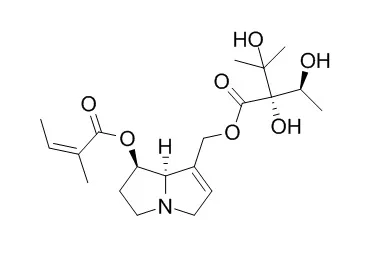| In vitro: |
| Mol Nutr Food Res. 2014 May;58(5):995-1004. | | Structure-activity relationship in the passage of different pyrrolizidine alkaloids through the gastrointestinal barrier: ABCB1 excretes heliotrine and echimidine.[Pubmed: 24375927] | 1,2-Unsaturated pyrrolizidine alkaloids (PA) are found in plants such as Asteraceae and Boraginaceae families. Acute PA poisoning via contaminated food or feed causes severe damage to liver depending on species-specific oral bioavailability. For assessing PA bioavailability, their passage across the intestinal barrier was investigated using Caco-2 cells.
METHODS AND RESULTS:
Differentiated Caco-2 cells were exposed in transport chambers to the PA heliotrine (Hn), Echimidine (Em), senecionine (Sc), and senkirkine (Sk). Cell supernatants were analyzed by LC-MS/MS.
PA pass Caco-2 monolayer from the apical into basolateral compartment depending on their chemical structure. Compared to the cyclic diesters Sc and Sk with a passage rate of 47% ± 4 and 40% ± 3, respectively, the transferred amount of the monoester Hn (32% ± 3) and open-chained diester Em (13% ± 2) was substantially lower. This suggested an active transport of Hn and Em. Using Madin-Darby canine kidney II/P-glycoprotein (ABCB1)-overexpressing cells, the active excretion of Hn and Em by ABCB1 from the gastrointestinal epithelium into the gut lumen was shown.
CONCLUSIONS:
PA cross the intestinal barrier structure-dependently. The passage of the noncyclic PA Hn and Em is reduced by an ABCB1-driven efflux into the gastrointestinal lumen resulting in a decreased oral bioavailability. | | J.Food Compos. Anal., 2013, 29(2):106-9. | | Persistence of echimidine, a hepatotoxic pyrrolizidine alkaloid, from honey into mead[Reference: WebLink] | Honey produced by bees foraging on Echium plantagineum is known to contain dehydropyrrolizidine alkaloids characteristic of the plant.
METHODS AND RESULTS:
Following a prolific growth of E. plantagineum in the wake of Australian bushfires, two samples of mead, a fermented drink made from honey, and the honey used to prepare the mead were analyzed for the presence of Echium-related dehydropyrrolizidine alkaloids. HPLC–esiMS and MS/MS analysis of the alkaloidal fractions obtained using strong cation exchange, solid phase extraction unequivocally confirmed the presence of Echimidine, a major hepatotoxic dehydropyrrolizidine alkaloid produced by E. plantagineum, in the honey (780 ng/g) and in the subsequent mead samples (236–540 ng/mL).
CONCLUSIONS:
The results from this limited, and specifically targeted sample set, while not indicative of the extent of the presence of Echimidine (or other dehydropyrrolizidine alkaloids) in meads, reinforce the need for a wider survey and perhaps subsequent routine monitoring to determine the potential contribution to long-term, low-level or intermittent exposure to these toxic alkaloids and consequent chronic disease development. | | Turk. J. Med. Sci., 2001, 31(6):487-92. | | Antifungal activities of different extracts and echimidine-N-oxide from Symphytum sylvaticum Boiss. subsp. sepulcrale (Boiss. & Bal.) Greuter & Burdet var. sepulcrale.[Reference: WebLink] |
METHODS AND RESULTS:
Antifungal activity was determined by the tube dilution method on different extracts of Symphytum sylvaticum Boiss. subsp. sepulcrale (Boiss. & Bal.) Greuter & Burdet var. sepulcrale. The antifungal activity of the isolated compound from the root alkaloid fraction (Echimidine-N-Oxide) was also tested against ten fungal cultures.
CONCLUSIONS:
The activity was found to be mainly due to Echimidine-N-Oxide (ENO). The quantitative determination of ENO was also carried out with capillary gas chromatography in the roots and the aerial parts of the plant. |
|






 Cell. 2018 Jan 11;172(1-2):249-261.e12. doi: 10.1016/j.cell.2017.12.019.IF=36.216(2019)
Cell. 2018 Jan 11;172(1-2):249-261.e12. doi: 10.1016/j.cell.2017.12.019.IF=36.216(2019) Cell Metab. 2020 Mar 3;31(3):534-548.e5. doi: 10.1016/j.cmet.2020.01.002.IF=22.415(2019)
Cell Metab. 2020 Mar 3;31(3):534-548.e5. doi: 10.1016/j.cmet.2020.01.002.IF=22.415(2019) Mol Cell. 2017 Nov 16;68(4):673-685.e6. doi: 10.1016/j.molcel.2017.10.022.IF=14.548(2019)
Mol Cell. 2017 Nov 16;68(4):673-685.e6. doi: 10.1016/j.molcel.2017.10.022.IF=14.548(2019)